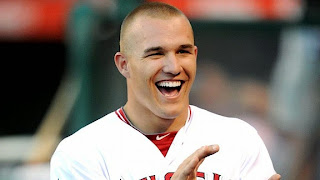Having thought through a few more of the contexts that this daily display of "QMAX extremes" organized by team can provide, we've slogged through more of the data collection in order to provide a few generalizations. First, here's the April chart complete (you'll need to click on it for easy reading):
Here are some basic numbers relating to the April data. Overall winning percentage in what we've called the "top hit prevention games" ("1S," the best, and "2S," next best) is .759. (Breaking that down further, that's .800 for 1S starts, .728 for 2S starts.)
The overall winning percentage in the "hit hard" region of the QMAX chart ("6S," second to worst, and "7S," was .239 in April. (Again, breaking that down further, that's .322 in 6S starts, and .145 for 7S starts.)
The actual number of starting pitcher wins, as opposed to team wins, varies somewhat, of course--which makes sense when you think about it. The overall WPCT will tend to cleave toward the middle: teams will blow a portion of their starters' better starts, and they'll recover from a portion of their starters' poor outings. The numbers quoted above are the team WPCTs.
All team "luck" is not created equal, of course. In each of the "extremes" there is fluctuation in the W-L record. As you can see, the Blue Jays actually had the most "1S-2S" games in April, with nine, but were only 5-4 in those games. Similarly, the Cubs managed to go 3-2 when their starters pitched poorly--a .600 WPCT as compared with the overall .239.
Now lets move on to the May data (same reading caveat as above...click!!):
As you can see, we've modified the chart a bit to allow for us to collate the year-to-date data with the monthly collation: you can see that at the bottom of the chart, in the rows marked "12S-tot" and "67S-tot." As you'll also see, there are daily fluctuations in the ratio of 1S/2S to 6S/7S games that are often quite extreme, but there is a relative balance in their overall numbers (as of May 21st, each category accounted for around 26% of the total games).
This fluctuates according to the overall run scoring environment that exists in the game over various times (the ratios weren't in balance in 2000, for example, when top hit prevention starts (1S/2S) were only 20% of all games, and "hit hard" games (6S/7S) comprised 32% of the total.
The general data that we tracked in April (overall WPCTs) remains very close to what we saw in that first month of 2015: .744 for 1S/2S games, .238 for 6S/7S games. There were a few more "blown games" in the 1S data, lowering the .800 April WPCT to .766 in May; and there were also some random perturbations in the 6S/7S data that made 6S games less successful (.295 as opposed to .322 in April) and 7S games more successful (.172 in May, .145 in April).
Where we can start to see larger patterns and where overall team performance starts to separate, however, is when we combine all of this data into season-to-date breakouts for each team. The most interesting extreme in
the table at right can be found in the 1S/2S data. Examine that info for two teams: the Angels (LAA) and the Yankees (NYY).
Yes, that's right. The Angels have had nearly six times as many 1S/2S games thus far in 2015 (seventeen) than the Yankees (who've had only three). Early in May, folks were touting the Yankees as a team that had pulled out of its 2014 wreckage; the problem with that notion is reflected here, in their league-trailing performance in top hit prevention games from its starters. Without a reversal in that performance deficit, the Yankees will be hard-pressed to play .500 ball over 2015.
Of course, once we have the extremes, we can calculate the middle. And as you can see, we've collated the mid-range QMAX performances (3S, 4S, 5S) and have the individual team W-L data over at the right of the table.
The performance extremes in the 3S-5S range are interesting in their own right. The Astros' ability to hit HRs has brought them early and outsized success in the "meh" region of starting pitcher performance as measured by QMAX (18-8). The A's, however, have been hammered in this region (5-14).
It's clear that some teams are getting more 3S games here than 5S games, and we'd have to adjust this data to be just a bit more granular to capture that. But one value of this tripartite approach is that we can see the overall shape more clearly. For example, the Padres' starters are virtually living in the middle (30 out of 42 games, or 71% (as opposed to the overall MLB average of 48%). Being in this region can only work if one of two things is true: 1) your pitchers are throwing far more 3S games than 5S games or 2) your offense happens to cluster well in these games. (OK, a third reason: you can have an insanely great bullpen, which is a key reason why the Royals have flown so high thus far in 2015.)
More on this later, time permitting.
 And the total is now up to eighteen thanks to three CGs on May 25 and the second appearance on the list by Felix Hernandez on 5/27:
And the total is now up to eighteen thanks to three CGs on May 25 and the second appearance on the list by Felix Hernandez on 5/27: --Jesse Hahn of the A's four-hit the Detroit Tigers in a 4-0 Oakland win, striking out five and walking one.
--Jesse Hahn of the A's four-hit the Detroit Tigers in a 4-0 Oakland win, striking out five and walking one.


















